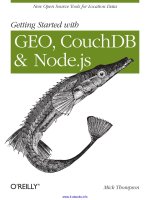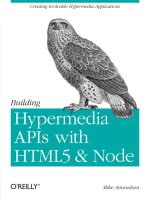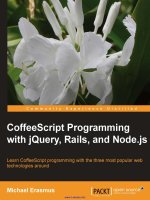16 message passing and node classification
Bạn đang xem bản rút gọn của tài liệu. Xem và tải ngay bản đầy đủ của tài liệu tại đây (48.73 MB, 87 trang )
CS224W: Analysis of Networks
Jure Leskovec with Srijan Kumar, Stanford University
Main question today: Given a network with
labels on some nodes, how do we assign
labels to all other nodes in the network?
¡ Example: In a network, some nodes are
fraudsters and some nodes are fully trusted.
How do you find the other fraudsters and
trustworthy nodes?
¡
11/15/18
Jure Leskovec, Stanford CS224W: Analysis of Networks,
2
Main question today: Given a network with
labels on some nodes, how do we assign
labels to all other nodes in the network?
¡ Collective classification: Idea of assigning
labels to all nodes in a network together
¡ Intuition: Correlations exist in networks.
Leverage them!
¡ We will look at three techniques today:
¡
§ Relational classification
§ Iterative classification
§ Belief propagation
11/15/18
Jure Leskovec, Stanford CS224W: Analysis of Networks,
3
Individual behaviors are correlated in a
network environment
¡ Three types of dependencies that lead to
correlation:
¡
Homophily
11/15/18
Influence
Confounding
Jure Leskovec, Stanford CS224W: Analysis of Networks,
4
Example:
¡ Real social network
§ Nodes = people
§ Edges = friendship
§ Node color = race
¡
People are
segregated by race
due to homophily
(Easley and Kleinberg, 2010)
11/15/18
Jure Leskovec, Stanford CS224W: Analysis of Networks,
5
¡
How to leverage this correlation observed in
networks to help predict user attributes or
interests?
How to predict the labels for the nodes in yellow?
11/15/18
Jure Leskovec, Stanford CS224W: Analysis of Networks,
6
¡
Similar entities are typically close together or
directly connected:
§ “Guilt-by-association”: If I am connected to a
node with label X, then I am likely to have label X
as well.
§ Example: Malicious/benign web page:
Malicious web pages link to one another to
increase visibility, look credible, and rank
higher in search engines
11/15/18
Jure Leskovec, Stanford CS224W: Analysis of Networks,
7
¡
Classification label of an object O in network
may depend on:
§ Features of O
§ Labels of the objects in O’s neighborhood
§ Features of objects in O’s neighborhood
11/15/18
Jure Leskovec, Stanford CS224W: Analysis of Networks,
8
Given:
• graph and
• few labeled nodes
Find: class (red/green)
for rest nodes
Assuming: networks
have homophily
11/15/18
Jure Leskovec, Stanford CS224W: Analysis of Networks,
9
¡
Let ! be a "×" (weighted) adjacency matrix
over " nodes
¡
Let Y = −1, 0, 1
)
be a vector of labels:
§ 1: positive node, known to be involved in a gene
function/biological process
§ -1: negative node
§ 0: unlabeled node
¡
Goal: Predict which unlabeled nodes are
likely positive
11/15/18
Jure Leskovec, Stanford CS224W: Analysis of Networks,
11
Intuition: simultaneous classification of
interlinked objects using correlations
¡ Several applications
¡
§
§
§
§
§
§
§
11/15/18
Document classification
Part of speech tagging
Link prediction
Optical character recognition
Image/3D data segmentation
Entity resolution in sensor networks
Spam and fraud detection
Jure Leskovec, Stanford CS224W: Analysis of Networks,
12
¡
Markov Assumption: the label Yi of one node i
depends on the label of its neighbors Ni
!(#$ |&) = ! #$ )$ )
¡
Collective classification involves 3 steps:
Local Classifier
• Assign initial label
11/15/18
Relational Classifier
Collective Inference
• Capture
correlations
between nodes
• Propagate
correlations
through network
Jure Leskovec, Stanford CS224W: Analysis of Networks,
13
Local Classifier
• Assign initial
label
Relational Classifier
• Capture
correlations
between nodes
Collective Inference
• Propagate
correlations
through network
11/15/18
Local Classifier: used for initial label assignment
§ Predicts label based on node attributes/features
§ Classical classification learning
§ Does not employ network information
Relational Classifier: capture correlations based
on the network
•
•
Learn a classifier from the labels or/and attributes
of its neighbors to label one node
Network information is used
Collective Inference: propagate the correlation
•
•
•
Apply relational classifier to each node iteratively
Iterate until the inconsistency between neighboring
labels is minimized
Network structure substantially affects the final
prediction
Jure Leskovec, Stanford CS224W: Analysis of Networks,
14
Exact inference is practical only when the
network satisfies certain conditions
¡ We will look at techniques for approximate
inference:
¡
§ Relational classification
§ Iterative classification
§ Belief propagation
¡
All are iterative algorithms
11/15/18
Jure Leskovec, Stanford CS224W: Analysis of Networks,
16
How to predict the labels Yi for the nodes i in
yellow?
¡ Each node i has a feature vector fi
¡ Labels for some nodes are given (+ for green, - for
blue)
¡ Task: find P(Yi) given all features and the network
¡
P(Yi) = ?
11/15/18
Jure Leskovec, Stanford CS224W: Analysis of Networks,
17
Basic idea: Class probability of Yi is a weighted
average of class probabilities of its neighbors.
¡ For labeled nodes, initialize with ground-truth Y
labels
¡ For unlabeled nodes, Initialize Y uniformly.
¡ Update all nodes in a random order till convergence
or till maximum number of iterations is reached
¡
11/15/18
Jure Leskovec, Stanford CS224W: Analysis of Networks,
18
¡
Repeat for each node i and label c
¡
¡
W(i,j) is the edge strength from i to j
|Ni| is the number of neighbors of I
¡
Challenges:
§ Convergence is not guaranteed
§ Model cannot use node feature information
11/15/18
Jure Leskovec, Stanford CS224W: Analysis of Networks,
19
Initialization: All labeled nodes to their labels
and all unlabeled nodes uniformly
P(Y = 1) = 1
P(Y = 1) = 0.5
P(Y=1) = 0.5
P(Y = 1) = 0.5
P(Y = 1) = 0
P(Y=1) = 0.5
P(Y = 1) = 0.5
P(Y = 1) = 1
11/15/18
Jure Leskovec, Stanford CS224W: Analysis of Networks,
P(Y = 1) = 0
20
¡
Update for the 1st Iteration:
§ For node 3, N3={1,2,4}
P(Y = 1) = 1
P(Y = 1) = 0.5
P(Y=1|N3) = 1/3 (0 + 0 + 0.5) = 0.17
P(Y = 1) = 0.5
P(Y = 1) = 0
P(Y=1) = 0.5
P(Y = 1) = 0.5
P(Y = 1) = 1
11/15/18
P(Y = 1) = 0
Jure Leskovec, Stanford CS224W: Analysis of Networks,
21
¡
Update for the 1st Iteration:
§ For node 4, N4={1,3, 5, 6}
P(Y = 1) = 1
P(Y = 1) = 0.5
P(Y=1) = 0.17
P(Y = 1) = 0.5
P(Y = 1) = 0
P(Y=1|N4)= ¼(0+
0.17+0.5+1)
= 0.42
P(Y = 1) = 0.5
P(Y = 1) = 1
11/15/18
P(Y = 1) = 0
Jure Leskovec, Stanford CS224W: Analysis of Networks,
22
¡
Update for the 1st Iteration:
§ For node 5, N5={4,6,7,8}
P(Y = 1) = 1
P(Y = 1) = 0.5
P(Y=1|N5) =
¼ (0.42+1+1+0.5) = 0.73
P(Y=1) = 0.17
P(Y = 1) = 0
P(Y=1|N4)= 0.42
P(Y = 1) = 0.5
P(Y = 1) = 1
11/15/18
P(Y = 1) = 0
Jure Leskovec, Stanford CS224W: Analysis of Networks,
23
After Iteration 1
P(Y = 1) = 0.17
P(Y = 1) = 0.73
P(Y = 1) = 1.00
P(Y = 1) = 0
P(Y = 1) = 0.91
P(Y = 1) =
0.42
P(Y = 1) = 0
11/15/18
Jure Leskovec, Stanford CS224W: Analysis of Networks,
24
After Iteration 2
P(Y = 1) = 0.14
P(Y = 1) = 0.85
P(Y = 1) = 1.00
P(Y = 1) = 0
P(Y = 1) = 0.95
P(Y = 1) =
0.47
P(Y = 1) = 0
11/15/18
Jure Leskovec, Stanford CS224W: Analysis of Networks,
25
After Iteration 3
P(Y = 1) = 0.16
P(Y = 1) = 0.86
P(Y = 1) = 1.00
P(Y = 1) = 0
P(Y = 1) = 0.95
P(Y = 1) =
0.50
P(Y = 1) = 0
11/15/18
Jure Leskovec, Stanford CS224W: Analysis of Networks,
26
After Iteration 4
P(Y = 1) = 0.16
P(Y = 1) = 0.86
P(Y = 1) = 1.00
P(Y = 1) = 0
P(Y = 1) = 0.95
P(Y = 1) =
0.51
P(Y = 1) = 0
11/15/18
Jure Leskovec, Stanford CS224W: Analysis of Networks,
27









